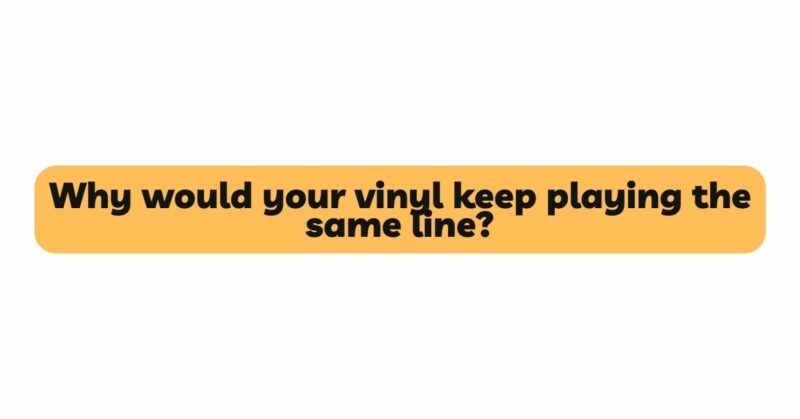The resurgence of vinyl records in recent years has rekindled the love for analog music playback. The rich sound, the tangible experience, and the connection to music’s past are some of the factors that draw enthusiasts to vinyl. However, this enchanting experience can sometimes be disrupted by a puzzling phenomenon: the continuous playback of the same line or snippet of a song. Why does your vinyl keep playing the same line? In this exploration, we venture into the realm of vinyl playback mechanics to understand the intricate factors that lead to this persistent loop.
The Enigma of Continuous Line Playback
Imagine immersing yourself in the captivating sound of a vinyl record. You’re engrossed in the music, anticipating the seamless transition to the next track. But instead of moving forward, the same line or segment of the song is caught in an unending loop, repeating itself without pause. This baffling occurrence can frustrate even the most dedicated vinyl aficionado, prompting questions about the inner workings of the medium.
1. Groove Geometry and Locked Grooves
The foundation of vinyl playback lies in the grooves etched onto the surface of the record. These grooves are meticulously cut to capture the audio signal, converting it into audible sound when the stylus traces their contours. Yet, the intricate geometry of the grooves can sometimes lead to what is known as a “locked groove.”
Locked grooves occur when the stylus reaches the end of a groove and becomes trapped in a loop within that groove due to its particular geometry. Instead of transitioning to the next groove, the stylus traces the same path repeatedly, causing a specific line or segment of the song to play in a continuous loop. This phenomenon can be a consequence of the groove layout, inadvertently ensnaring the stylus in a cyclical pattern.
2. Tracking and Anti-Skate Settings
The accurate traversal of the grooves by the stylus depends on two essential settings: tracking force and anti-skate. Tracking force refers to the downward pressure exerted by the stylus on the grooves. If the tracking force is improperly calibrated, the stylus may dig too deeply into the groove, leading to a momentary interruption and the repetition of a segment. Anti-skate, meanwhile, counteracts the inward pull of the grooves, helping the stylus maintain its proper alignment.
When the tracking force or anti-skate settings are incorrectly adjusted, the stylus may struggle to follow the grooves smoothly. This struggle can lead to the repetition of specific sections, where the stylus becomes momentarily trapped in a groove or line, initiating an unintended loop.
3. Worn or Damaged Stylus
The stylus, a crucial element of vinyl playback, reads the grooves and translates them into sound. Over time, styluses can wear down due to regular use, accumulation of dust or debris, or improper handling. A worn or damaged stylus might fail to accurately trace the intricate contours of the grooves, causing it to skip or repeat portions of a song.
When the stylus encounters a damaged portion of the groove, it can cause a momentary disruption in its path. This disruption can lead to the stylus skipping back and replaying the same line, initiating a looping playback of the affected section.
4. Vibrations and External Factors
Vinyl playback is remarkably sensitive to vibrations originating from various sources. External vibrations—whether caused by footsteps, nearby speakers, or other environmental factors—can perturb the stylus’s trajectory. These vibrations can lead to the stylus bouncing or jumping within the grooves, resulting in a repeated playback of a specific line or segment.
Moreover, vibrations can propagate through the turntable itself, disrupting the delicate equilibrium required for precise playback. Even the resonance generated by the speakers can inadvertently contribute to the phenomenon of line repetition if not managed effectively.
5. Record Warping and Manufacturing Defects
Vinyl records, due to their material nature, are susceptible to warping caused by temperature fluctuations, improper storage, or manufacturing defects. A warped record can disrupt the trajectory of the stylus, causing it to bounce or skip, which in turn results in the repetition of sections of the track. Similarly, manufacturing defects in the pressing process, such as uneven grooves or imperfections in the vinyl material, can hinder the stylus’s smooth movement, ultimately leading to repetition.
Preserving the Vinyl Experience
Encountering continuous line playback on your vinyl records might be a moment of frustration, but it’s also an opportunity to engage with the nuances of analog playback. These intricacies remind us that vinyl playback is a delicate interplay of mechanics, physics, and technology, each contributing to the unique experience.
The vinyl community often embraces these subtleties as part of the charm of analog playback. The imperfections, the tactile engagement, and even the occasional looping contribute to the depth of the musical journey. Each repetition becomes a thread in the narrative, binding the listener to the medium and the artist’s creative expression.
Conclusion
The enigma of continuous line playback on vinyl unveils the intricate interplay between the stylus, the grooves, and the intricate mechanics of the turntable. From locked grooves to stylus wear, external vibrations, and manufacturing anomalies, the factors that contribute to this phenomenon are multifaceted, revealing the complexity of analog playback.
When your vinyl plays the same line repeatedly, it’s a reminder that even in the age of digital precision, analog formats possess their own captivating quirks and idiosyncrasies. Embracing these subtleties enriches the vinyl experience, fostering a deeper understanding of the medium’s essence and a stronger connection to the music it brings to life.


